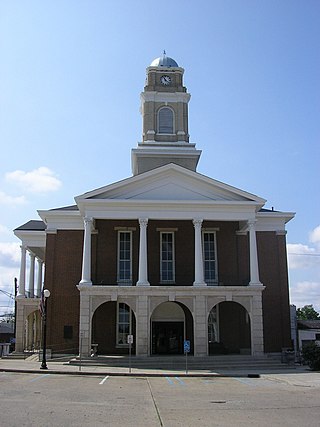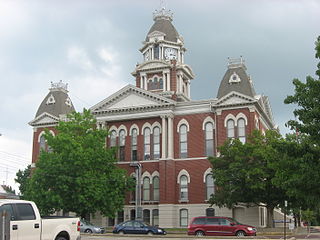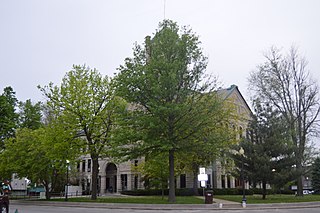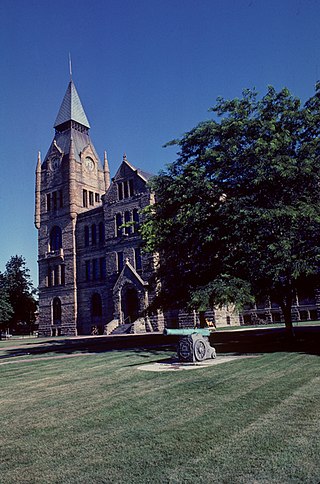
The Sycamore Historic District is a meandering area encompassing 99 acres (400,000 m2) of the land in and around the downtown of the DeKalb County, Illinois county seat, Sycamore. The area includes historic buildings and a number of historical and Victorian homes. Some significant structures are among those located within the Historic District including the DeKalb County Courthouse and the Sycamore Public Library. The district has been listed on the National Register of Historic Places since May 2, 1978.

Pittsfield Historic District is a historic district in Pittsfield, Illinois, the county seat of Pike County. The district is centered on the Pike County Courthouse and the surrounding courthouse square; it also encompasses nearby residential areas. The courthouse was built in 1894–95; architect Henry Elliott based its Romanesque design off his earlier design for the Edgar County, Illinois, courthouse. The district's historic commercial buildings are mostly located on the courthouse square, which surrounds the courthouse; these buildings are mainly two-story brick structures. The Italianate and Queen Anne styles are prevalent among the district's houses, with the former being the most prominent; the Greek Revival and Federal styles are also common in the district's earlier homes.

The Oregon Commercial Historic District is a historic district in Oregon, Illinois, that has been listed on the National Register of Historic Places since 2006. The district is roughly bordered by Jefferson, Franklin, 5th and 3rd Streets in Oregon. It is one of six Oregon sites listed on the National Register and one of three to be so listed since the turn of the 21st century. The other two are the Oregon Public Library, listed in 2003, and the Chana School, listed in 2005.

The Steele County Courthouse is the seat of government for Steele County, located in Owatonna, Minnesota, United States. It was built in 1891. The courthouse is a three-story Austin red-brick building with red mortar, accented with Lake Superior brown stone. It was designed by T. Dudley Allen of Minneapolis in a Romanesque Revival and Italianate style, featuring corner towers, a turret, and a large clock on four sides. Windows are arched and a statue representing Mercy, Law, and Justice sits above the north face of the building. Polished granite columns support double arches at the entrances. The interior is decorated with wainscoting, woodwork, and an ornate oak staircase. The courthouse was listed on the National Register of Historic Places in 1976 for having local significance in the themes of architecture and politics/government. It was nominated for its Romanesque Revival architecture and long service as Steele County's government seat.

The Lancaster Commercial Historic District is a registered historic district located in Lancaster, Kentucky that was added to the United States National Register of Historic Places in 1984.

The Central Geneva Historic District is a set of 102 buildings and structures in Geneva, Illinois. Of those, 68 contribute to the district's historical integrity. The district is representative of southern Geneva, south of Illinois Route 38. Among the noted buildings is the Kane County Courthouse and the Frank Lloyd Wright-designed P. D. Hoyt House. The district was added to the National Register of Historic Places in 1979, and was enlarged in 2017.

Ripley Historic District is a national historic district located at Ripley, Jackson County, West Virginia. It encompasses 110 contributing buildings, one contributing site, and one contributing structure that include the commercial and civic core of the town, and surrounding residential buildings. It includes example of popular architectural styles of the late-19th and early- to mid-20th century, including Queen Anne, Colonial Revival, Art Moderne, Neo-Classical Revival, Italianate and Modern. Notable buildings include the U.S. Post Office, Phillips/Pfost House, Alpine Theater, Hockenberry Store building, Jackson County Courthouse (1918-1920), the Beymer House, and the Hinzman House. Located within the district is the separately listed Clerc-Carson House.

The Morris Downtown Commercial Historic District is a historic district in downtown Morris. The district includes 116 buildings and a monument; 105 of these are commercial buildings, and 87 are contributing properties to the district.

The Centralia Commercial Historic District is a historic commercial district comprising several blocks of Broadway in downtown Centralia, Illinois. The district includes 57 contributing buildings as well as a historic water tower and sign. Centralia's business district developed around the Illinois Central Railroad tracks, as the town was established by and named for the railroad. The earliest buildings in the district date from the 1850s, as the city was platted in 1853. Centralia's first commercial buildings were mainly designed in the Italianate style, which was predominant until the end of the 19th century; the Romanesque Revival style also gained popularity in the 1880s. Around the turn of the century, the Commercial style became the most popular style in the district. The Renaissance Revival and Classical Revival styles can also be seen in buildings from this era, and by the 1930s Art Deco and Modernist architecture became popular.

The Marshall Business Historic District is a historic district located in downtown Marshall, Illinois. The district encompasses the city's historic commercial center and includes 56 buildings and structures, 46 of which are contributing buildings. Marshall's courthouse square is a central feature of the district; the square includes the Italian Renaissance Revival Clark County Courthouse, which was built in 1903. The other buildings in the district, mainly commercial and government buildings, were built from the 1830s to the 1960s; however, most of the buildings were built between 1870 and 1910, Marshall's largest growth period. The buildings from this era are mostly designed in the Italianate, Romanesque, and Italian Renaissance Revival styles.

The Shelbyville Historic District is a historic district encompassing the core of Shelbyville, Illinois. The district includes 398 buildings, 293 of which are contributing buildings. The section of Shelbyville laid out at the city's founding in 1827 forms the center of the district. Shelbyville's public square, which includes the 1880 Shelby County Courthouse and a veterans' memorial, is the central feature of this part of the historic district. The original section of Shelbyville also includes significant commercial and government buildings. The district also includes Shelbyville's oldest residential areas, which developed out from the 1827 core. The Italianate style is the most prominent architectural style in the district, both in homes and commercial buildings; other common architectural styles include Greek Revival, Gothic Revival, Second Empire, and Queen Anne.

The Taylorville Courthouse Square Historic District is a 19.7-acre (8.0 ha) historic district located in downtown Taylorville, Illinois. The district encompasses most of Taylorville's downtown business center; while it is primarily commercial, it also includes several important government buildings. The Christian County Courthouse, a Romanesque building constructed in 1902, forms the centerpiece of the district. While development in the district began in the late 1830s, only two buildings in the district predate 1875. The first major growth period represented in the district occurred from 1875 to 1900; the commercial buildings from this period feature Italianate, Romanesque, Beaux-Arts, and Queen Anne designs. Another period of construction followed the courthouse's opening; in the ensuing decades, several Classical Revival and Prairie School buildings opened, as did the Mission Revival public library. Since 1935, the district has remained largely intact.

The Galesburg Historic District is a 496-acre (201 ha) historic district in Galesburg, Illinois. The district includes 1049 contributing buildings and contains the town's original plat as well as several older neighborhoods. The section of the district south of North Street encompasses Galesburg's historic city center and its most significant landmarks, such as the Knox County Courthouse, the Knox County Jail, the Burlington Depot, and Main Street's commercial buildings. Knox College, the school Galesburg was founded to serve, and its historic Old Main are also located in the southern half of the district. The area north of North Street is mainly residential and is dominated by Queen Anne and Classical Revival houses, including many transitional houses displaying elements of both styles.

Morganton Downtown Historic District is a national historic district located at Morganton, Burke County, North Carolina. It encompasses 62 contributing buildings in the central business district of Morganton. It includes commercial, industrial, and governmental buildings built between about 1889 and 1940. It includes representative examples of Classical Revival, Art Deco, and Italianate style architecture. Notable buildings include the Old Burke County Courthouse, Morganton Post Office, and the Morganton Community House.

The Monticello Courthouse Square Historic District is a historic district in downtown Monticello, Illinois. The district includes the historic commercial center of the city, the county seat of Piatt County, and is centered on the Piatt County Courthouse. 80 buildings are included in the district, 73 of which are considered contributing to its historic character. The district was added to the National Register of Historic Places on November 5, 2009.

The Clay County Courthouse, located at 300 Broadway Street in Louisville, is the county courthouse serving Clay County, Illinois. Built in 1913, the courthouse was Clay County's fourth courthouse; it has served continuously as the seat of Clay County government since its opening. Architect Joseph W. Royer, who planned several other Illinois courthouses, designed the Classical Revival building. The courthouse was added to the National Register of Historic Places in 2015.

The Monmouth Courthouse Commercial Historic District is a historic district located in downtown Monmouth, Illinois. The district encompasses Monmouth's historic commercial core and includes 63 contributing buildings and sites, most of them commercial buildings. Growth in the district began in the 1850s and continued through the 1920s, with occasional spurts in between due to rebuilding after fires. The Public Square, a small park within a roundabout, serves as the anchor of the district; the Warren County Courthouse, a Richardsonian Romanesque building completed in 1895, is its namesake building. Most of the commercial buildings within the district have Italianate or Commercial Style designs, with the former style generally predating the latter. Examples of the Queen Anne, Classical Revival, Art Deco, and Moderne styles can also be seen in the district.

The Downtown Aledo Historic District is a national historic district located in downtown Aledo, Illinois. The district includes 75 contributing buildings and a park. The majority of the buildings are commercial structures, but the district also includes the city's Chicago, Burlington and Quincy Railroad station and both the city's and Mercer County's major government buildings. Development in the district began in the 1850s, and the oldest surviving buildings date from the following decade. The district includes examples of many prominent American architectural styles from the mid-19th century onward; the most prevalent styles are Classical Revival, Romanesque Revival, and Italianate.

Winterset Courthouse Square Commercial Historic District is a nationally recognized historic district located in Winterset, Iowa, United States. It was listed on the National Register of Historic Places in 2015. At the time of its nomination the district consisted of 82 resources, including 74 contributing buildings, seven noncontributing buildings, and one noncontributing object. The historic district covers most of the city's central business district in the original town plat. Most of the buildings are two-story, brick, commercial buildings. The commercial Italianate style is dominant, with Queen Anne, Romanesque Revival, and Neoclassical styles included. The Madison County Courthouse (1878) is a Renaissance Revival structure designed by Alfred H. Piquenard. Most of the buildings are brick construction, but four were constructed using locally quarried limestone. The stone buildings include the courthouse, the White, Munger and Company Store (1861), and the Sprague, Brown, and Knowlton Store (1866), all of which are individually listed on the National Register.

The Brown County Courthouse is a government building in Mount Sterling, the county seat of Brown County, Illinois, United States. Completed in 1868 and rebuilt around 1940, it is the second courthouse in the county's history.























